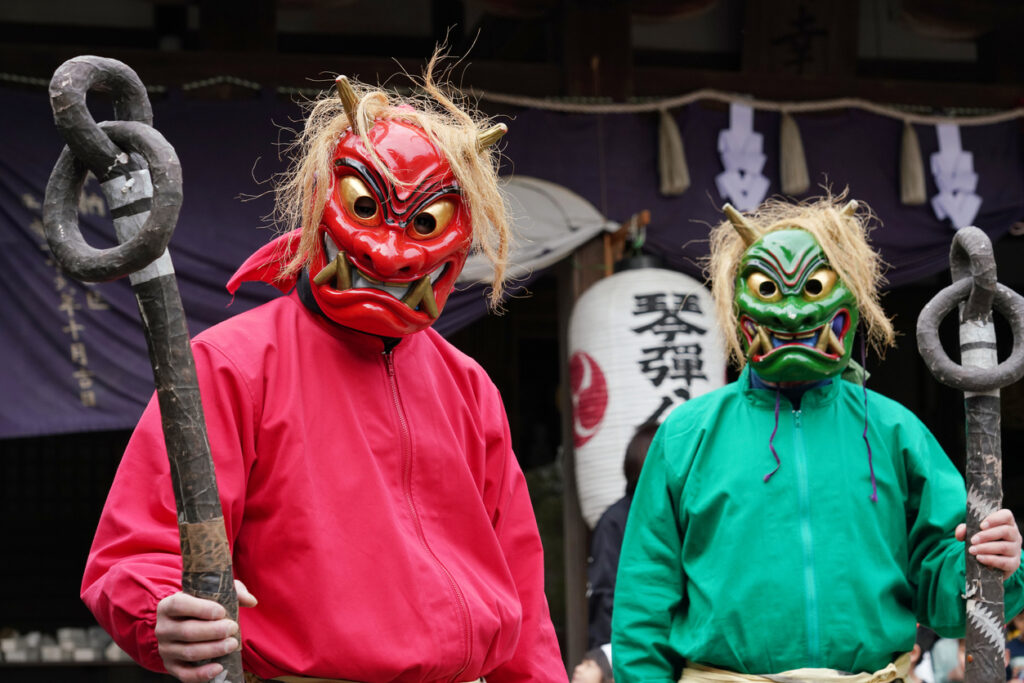The seasons are changing. It’s time to clean out all the bad energy from the biting cold winter and welcome Japan’s favorite season: spring.
However, before everyone goes crazy over cherry blossoms, Japanese families celebrate a unique tradition called Setsubun, held on the last day of winter according to the Japanese lunar calendar. Appropriately enough, the kanji for Setsubun (節分) translates to “seasonal division.” This year, it falls on Feb. 2.
While the tradition is for everyone, it’s a particular favorite among Japanese children. To celebrate Setsubun, families put roasted soybeans in asakemasu. That’s the wooden box that you sometimes see nihonshu (Japanese rice wine) served in. Family and regional traditions diverge regarding what comes next.
Exorcise your demons with beans

Typically, the head of the household throws these beans outside the front door, chanting the Setsubun mantra, “Oni wa soto! Fuku wa uchi!” (“Demons get out! good luck come in!”). Sometimes this role is given to a male in the house whose Chinese zodiac animal matches that year’s zodiac (2021 is the year of the ox).
In other families, the father dresses like an oni (demon) and the children throw beans at him while yelling, “Oni wa soto! Fuku wa uchi!“
This bean throwing tradition is called mamemaki, or “scattering of beans.” No matter the household’s particular way of doing mamemaki, the idea is to use these soybeans to symbolize purifying the home from evil spirits and misfortune lingering from the previous year.

To ensure good luck in the new year, the family also eats one roasted soybean for each year of their life (and sometimes one extra bean for the new year, again depending on the region).
Today, it’s more common for local shrines to hold mamemaki events—likely because Setsubun isn’t a public holiday. It’s also a popular holiday activity at many elementary schools and kindergartens.
Why do soybeans banish demons?

In Japanese folklore, beans are symbols of good luck. Soybeans are the second favorite (after rice, of course) in the Shinto tradition. Since soybeans are bigger and slightly more intimidating than rice, they became a favorite in the Setsubun tradition to ward off demons.
Soybeans aren’t the only type of food associated with Setsubun. Another one that has become quite popular in recent years is ehomaki (恵方巻), which translates to “lucky direction sushi roll.”
Traditionally, everyone holds one of these lucky sushi rolls and faces the eho, or “lucky direction,” decided for the year. Then, they eat the whole roll in silence. Doing this brings good luck to the sushi roll eater for the new lunar calendar year. The “lucky direction” for 2021 is south-south-east.
The best part? Once Setsubun is finished, all the delicious supermarket ehomaki leftover on sale for a discounted price.
Setsubun celebrations in Tokyo

Usually, there are awesome Setsubun celebrations all over Japan, but due to the coronavirus, some of them may be canceled. if you still plan on attending, check ahead before making your trip.
Senso-ji in Asakusa, Tokyo
At Sensō-ji, an ancient Buddhist temple in Asakusa, rather than saying “demons get out,” they say 千秋万歳福は内 or senshu banzei fuku wa uchi which is basically a prayer for eternal good luck. Celebrities also join the festivities and throw soybeans out to the crowds, so you might see some famous people you recognize there.
Tokyo Tower in Minato, Tokyo
Tokyo Tower is nice at any time of year, but the popular tourist spot gets extra festive during Setsubun. Drop by the second floor of their main deck to throw beans at some oni and meet Tokyo Tower’s own original mascots who will also make an appearance for the Setsubun festivities.
Kijin Shrine in Ranzan, Saitama
At Kijin Shrine, demons are worshipped as gods, so naturally, they wouldn’t want to drive them out, even for Setsubun! Instead of chanting “demons get out,” they mix it up a bit by saying, “Good luck come in, demons come in, bad spirits get out!” (福は内、鬼は内、悪魔は外, fuku wa uchi, oni wa uchi, akuma wa soto).
Other events around Japan
- Yasaka Shrine, Kyoto
- Domyoji Tenmangu Shrine, Osaka
- Tochouji Temple, Fukuoka
- Shiogama Shrine, Miyagi
- Hokkaido Shrine, Hokkaido
Have you ever been to a Setsubun celebration at a Japanese shrine? Let us know in the comments!





This site is protected by reCAPTCHA - Privacy Policy - Terms of Service